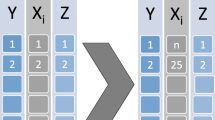Abstract
We illustrate the use of ‘reversible jump’ MCMC to automate the process of covariate selection in population PK/PD analyses. The output from such an approach can be used not only to determine the ‘best’ covariate model for each parameter, but also to formally measure the spread of uncertainty across all possible models, and to average inferences across a range of ‘good’ models. We examine the substantive impact of such model averaging compared to conditioning inferences on the ‘best’ model alone, and conclude that clinically significant differences between the two approaches can arise. The illustrative data that we consider pertain to the drug vancomycin in 59 neonates and infants, and all analyses are conducted using the WinBUGS software with newly developed ‘Jump’ interface installed.
Similar content being viewed by others
References
Akaike H (1974). A new look at statistical model identification. IEET T Automat Contr AU-19: 716–722
Vaida F and Blanchard S (2005). Conditional Akaike information for mixed-effects models. Biometrika 92: 351–370
Lavielle M and Mentré F (2007). Estimation of population pharmacokinetic parameters of saquinavir in HIV patients with the MONOLIX software. J Pharmacokinet Pharmacodyn 34: 229–249
Longford NT (2005). Editorial: model selection and efficiency—is ‘Which model ...?’ the right question?. J R Statist Soc A 168: 469–472
Hoeting JA, Madigan D, Raftery AE and Volinsky CT (1999). Bayesian model averaging: a tutorial. Stat Sci 14: 382–417
Green PJ (1995). Reversible jump Markov chain Monte Carlo computation and Bayesian model determination. Biometrika 82: 711–732
Lunn DJ, Thomas A, Best N and Spiegelhalter D (2000). WinBUGS—a Bayesian modelling framework: concepts, structure, and extensibility. Stat Comput 10: 325–337
Spiegelhalter D, Thomas A, Best N, Lunn D (2003) WinBUGS user manual, version 1.4. Medical Research Council Biostatistics Unit, Cambridge
Lunn DJ, Best N, Whittaker J (2005) Generic reversible jump MCMC using graphical models. Technical Report EPH-2005-01, Department of Epidemiology and Public Health, Imperial College London, UK
Lunn DJ, Whittaker JC and Best N (2006). A Bayesian toolkit for genetic association studies. Genet Epidemiol 30: 231–247
Grimsley C and Thomson AH (1999). Pharmacokinetics and dose requirements of vancomycin in neonates. Arch Dis Child Fetal Neonatal Ed 81: F221–F227
Bernardo JM and Smith AFM (1994). Bayesian theory. John Wiley & Sons, New York
Wakefield J and Bennett J (1996). The Bayesian modeling of covariates for population pharmacokinetic models. J Am Statist Ass 91: 917–927
Metropolis N, Rosenbluth AW, Rosenbluth MN, Teller AH and Teller E (1953). Equations of state calculations by fast computing machines. J Chem Phys 21: 1087–1091
Hastings WK (1970). Monte Carlo sampling-based methods using Markov chains and their applications. Biometrika 57: 97–109
Lunn DJ, Best N, Thomas A, Wakefield J and Spiegelhalter D (2002). Bayesian analysis of population PK/PD models: general concepts and software. J Pharmacokinet Pharmacodyn 29: 271–307
Lunn DJ, Wakefield J, Thomas A, Best N, Spiegelhalter D (1999) PKBugs user guide version 1.1. Dept. Epidemiology and Public Health, Imperial College School of Medicine, London
Lunn D (2006) WinBUGS ‘Jump’ Interface: Beta-Release User Manual. Dept. Epidemiology and Public Health, Imperial College School of Medicine, London
Brooks SP and Giudici P (1999). Convergence assessment for reversible jump MCMC simulations. In: Bernardo, JM, Berger, JO, Dawid, AP and Smith, AFM (eds) Bayesian statistics 6, pp 733–742. Oxford University Press, Oxford
Wakefield JC, Smith AFM, Racine-Poon A and Gelfand AE (1994). Bayesian analysis of linear and non-linear population models by using the Gibbs sampler. Appl Stat 43: 201–221
Kang D, Verotta D (2007) Reversible jump Markov chain Monte Carlo for deconvolution. J Pharmacokinet Pharmacodyn doi:10.1007/s10928-006-9045-x
Author information
Authors and Affiliations
Corresponding author
Rights and permissions
About this article
Cite this article
Lunn, D.J. Automated covariate selection and Bayesian model averaging in population PK/PD models. J Pharmacokinet Pharmacodyn 35, 85–100 (2008). https://doi.org/10.1007/s10928-007-9077-x
Received:
Accepted:
Published:
Issue Date:
DOI: https://doi.org/10.1007/s10928-007-9077-x




